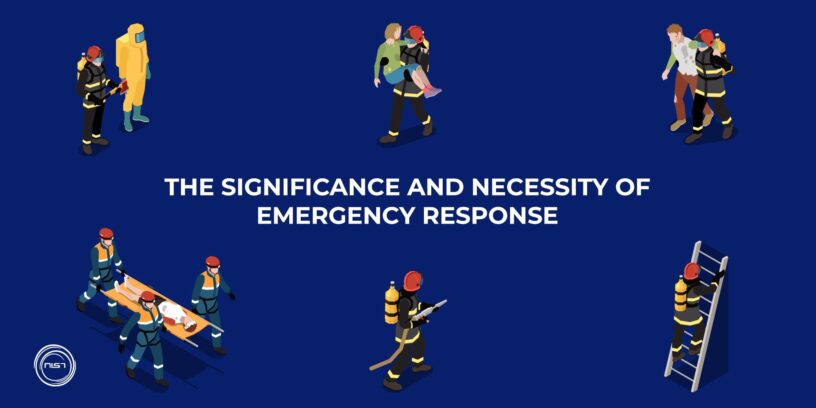Emergencies are events that pose a significant threat to public safety and can require immediate response. An emergency response is essential in aiding and saving people during crisis situations. Emergency responders play an important role by providing assistance to those who have been affected by the crisis, managing the situation, and coordinating with other agencies involved in the rescue effort.
Everyday, people face emergencies. Whether it’s a fire at the workplace or an accident on the road, everyone needs to be prepared for when something unexpected happens.
Emergency Response in the Workplace:
The main aim of an organisation is to make sure that it is able to handle any disaster before or during its occurrence, thus minimising any loss due to such a disaster in order to minimise damage and maximise business potential for the business or any organisation in general which is affected by the disaster.
An emergency response course must teach learners how to deal with unexpected situations in a safe and effective way. An emergency response course teaches basic life-saving skills. It also covers more specific topics like First aid and CPR so that responders are able to provide immediate care for victims during emergencies.
The four stages of emergency management are:
- Prevention
- Mitigation
- Preparedness and response
- Recovery
Emergency response – Goal:
The goal of an effective emergency response is to protect lives, maintain order, provide shelter for those who need it, evacuate individuals when necessary, and restore normalcy as quickly as possible.
Emergency response is very important in aiding and saving people during a crisis. It is the first step that is taken in order to avert an impending disaster. Early detection is the key to saving people, preventing injuries, and reducing the damage that a crisis can cause. Every country has its own emergency response protocol, and all of the necessary steps are taken in order to save as many people as possible.
Steps are taken in order to find out the nature of a crisis and the extent of the damage that it has caused. The information gathered is then used to devise a response plan. The plan was initiated in order to save as many people as possible and to minimise the damage that the crisis has caused.
Significance of HSMS Manual (or) Document:
A methodical document to deal with major emergencies is an important element of occupational health and safety (OHS) programs. A properly documented HSMS (Health and Safety Management System) would help in this regard.
An HSMS contains certain principles such as: commitment to a safe workplace; recognising and removing dangers, maintaining a safe workplace, including maintenance of safety records and information.
Besides the major benefit of providing guidance during an emergency, developing the plan has other advantages. You may discover unrecognised hazardous conditions that would aggravate an emergency situation, and you can work to eliminate them. The planning process may bring to light deficiencies, such as the lack of resources (equipment, trained personnel, supplies), or items that can be corrected before an emergency occurs.
An Emergency Team Formation:
Emergency response planning is made up of a number of components. The first and most important part is the assembly of the team. This team will consist of first responders, designated observers, and technical personnel. The team must be capable of responding to the emergency in a fast and effective manner. Once the team is assembled, the next step is to create a plan. A pre-disaster plan helps in the prevention of disasters by identifying hazards, creating strategies to reduce risks, and responding to those events when they occur.
This plan will outline the steps that will be followed during the emergency. It will also include a timeline for executing the plan.
It is important to remember that an emergency response plan is only as good as the people who use it frequently. People must be trained in how to respond to an emergency, and they must know when and how to use the resources at their disposal. Every person in an emergency situation must know how to act and think quickly. The best way to train people is through emergency response drills. These drills ensure that everyone knows how to react in an emergency and that the plan is actually being followed.
Emergency Response Training:
Emergency response is an important part of any safety course. It is not only important for first responders, but also for those who want to remain safe while an emergency is taking place. Every person who participates in an emergency must know how to respond. This includes knowing how to self-rescue, knowing the location of emergency personnel, and knowing how to use first-aid supplies.
Action and Evacuation during emergencies:
During an emergency scenario, it is essential that the first response mechanism be set up quickly so as to contain the damage or risk and minimise the damage or risks incurred by the people, places, and infrastructures in the affected region or zone, as well as minimise the impact on the general population of the community at large, which would be otherwise very hard to mitigate as the situation becomes worse with time due to a lack of immediate action taken by the disaster management authorities in reacting to an emergency.
In the event of an emergency or disaster, the first and foremost action that has to take place in order to minimise damage and casualties is planning a response to the event by identifying the cause of the incident or crisis and preparing a plan for mitigating any adverse effects on the affected population and/or environment by organising a communication system and making necessary arrangements for the evacuation of people, relocation of assets, and supply of goods and services to ensure public health, safety, security, and welfare during the crisis situation.
Another important aspect of emergency management is to identify warning signs early, which will help you to prevent future disasters.
Organizations must make an effort to prepare for an emergency event or crisis through Mock drills, simulation exercises, and training to reduce the impact of the emergency as well as increase its effectiveness.
An Emergency Response:
- Is critical for ensuring that people are safe and are able to return to their normal lives as soon as possible
- Efforts are made to reconnect people with their loved ones, and to restore essential services
- Must be well-organized
Every country has its own emergency response protocol, and all of the necessary steps are taken in order to save as many people as possible.
The most common method of emergency response today is a firefighting approach, using ladders, foam, extinguishers and various other equipment needed to fight the fire and prevent it from spreading beyond control and causing damage or injuries to personnel or nearby buildings.
The following are some of the methods and procedures used by a disaster management team:
- Identification of hazards
- Establishing an effective communication system
- Training of responders
- Stockpiling supplies and equipment
- Planning evacuation routes
- Defining roles and responsibilities among responders
- Planning rescue operations and identifying alternative in the event that any facility fails
- Planning security measures
- Providing adequate number of ambulances, providing adequate number of trained personnel with special skills, ensuring availability of medical aid, provisioning of food and water, organizing distribution of shelter and clothing etc.
Who can take the Emergency Response Team Training?
- Emergency & Communication Controllers
- Fire Marshals/ Traffic Wardens
- Fire Team Leader & Fire Fighting party
- First Aid Team Leader & Stretcher bearers
- Security Staff
Why NIST?
NIST provides emergency response training, Mock Drills etc. outlining effective management of emergency situations and all matters related to undesired incidents. Moreover, it provides an operational framework involving hazard prevention, emergency preparedness, and response. As a learning outcome of this emergency training, people-centered preventive approach to disaster risk, Disaster risk reduction practices, design and implementation of policies, plans and standards, disaster/hazard risk in management practises , Disaster management and mitigation measures, Disaster and its impacts on people, Risk communication and public awareness; hazard identification and warning; emergency planning and action; and disaster management are the important areas for which NIST is providing training facilities. Happy Learning!













Leave a Reply